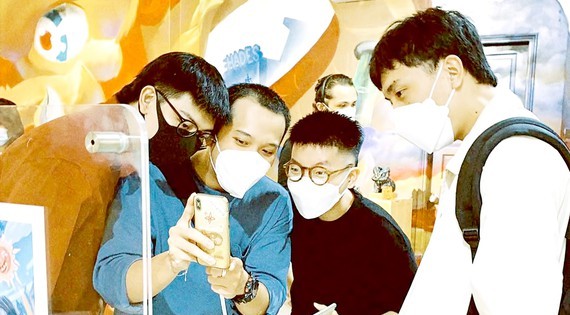Culture, art strive for digitization | Culture / art
[ad_1]
The Covid-19 pandemic is an external force that is accelerating the digitization process in culture and art. Some areas in which only existence and physical exhibitions seem suitable, such as sculptures or museums, have also adopted digitalization technologies in recent years.
In addition to scanning QR codes to get information on artifacts, some museums have digitized databases to set up virtual museums or intelligent museum applications. The Southern Women’s Museum is the first museum in Ho Chi Minh City to use hologram machines in the exhibition space. Using the hologram machine in combination with interactive 360-degree software and virtual reality (VR) technology, visitors can see artifacts on a 3D projection floating in the air. The Vietnam Fine Arts Museum also researched and launched the iMuseum VFA application – a multimedia application – to help users visit the museum remotely or in person.
Ms. Cao Thai Hoang Uyen, iMuseum project manager at Vietnam Fine Arts Museum, said that some of the world’s major museums had multimedia applications a long time ago and had more favorable funding terms than domestic ones. The iMuseum VFA project team had tested more than 160 versions before developing a suitable one. Technology is changing rapidly, so developers need to keep updating the current situation of the museum in order to provide an increasingly rich experience for the end user. In addition, the application supports up to eight languages, making it difficult to find experts in translation and proofreading.
In the field of sculpture, which only seems to show physical works, in recent years young sculptors have increasingly concentrated on performance applications and art videos or the combination of VR and Augmented Reality (AR). Sculptor Pham Dinh Tien, a lecturer at the HCMC University of Fine Arts, said there are many machines and software that aid in the physical shaping of sculptures. If artists want to be more innovative and creative, they need to continually update their technology knowledge. Sculptors now need to know more about programming to best get their message across, interact and attract more viewers.
Urgent motion
In the field of cinema, digitization is a much discussed story, especially in view of the huge archives currently kept at the film institutes in Hanoi and HCMC. According to Mr. Nguyen Xuan Du, vice director of the Vietnam Film Institute, this unit stores and preserves the national film collection of more than 80,000 16mm and 35mm plastic films, nearly 20,000 titles, tens of thousands of video and digital films, and other kinds of footage in other technical formats, including many valuable works of Vietnamese revolutionary cinema.
 ‘Chi Tu Hau’ (Ms. Tu Hau) is one of the classic Vietnamese films that has been digitized. (Photo: SGGP)
‘Chi Tu Hau’ (Ms. Tu Hau) is one of the classic Vietnamese films that has been digitized. (Photo: SGGP)According to Le Tuan Anh, deputy head of the technical department of the Vietnam Film Institute, the institute has been carrying out the digitization process since the end of 2005. In particular, it has been equipped with a 2K film scanner system since 2015 and has so far digitized around 4,000 films. However, the constant change in technology is one of the major obstacles. With every technological change, digitization work has to start all over again. The cost and time required to copy the entire amount of data each time are not small. The challenge is to both acquire new technologies and continue to maintain and maintain traditional plastic films. In fact, many valuable documentaries have been seriously damaged and degraded.
Digitization not only creates favorable conditions for preservation and storage methods, but also extends the lifespan of cinematic works. More importantly, valuable, historically and socially significant footage is given a more sustainable new life and vitality. It is also a prerequisite for promoting classical works and bringing them closer to the viewer, especially at the time when online platforms are thriving as they are now.
After digitization, many classic films from Vietnamese cinema were advertised in the Vietnamese Film Week event on VTV Go at the end of 2020. At the end of May this year, the Vietnamese Cartoons Week also presented 50 films on VTV Go. Previously, the animation archive with hundreds of works by the Vietnam Animation Studio was also published on the YouTube channel.Phim hoat hinh Vietnam“(Vietnamese Cartoons), which to date has attracted more than 560,000 subscribers and more than 160 million views. The Central Science and Documentary Film Studio also has a YouTube channel with dozen of featured documentaries. These two units also have fan pages for advertising. Most recently, in mid-July, the Vietnam Film Institute also launched a YouTube channel and uploaded the first nine films, which attracted millions of views.
In fact, after digitization, many movies, animations, documentaries, and science films have been published on many social networking platforms, especially YouTube, but not all channels are real. Digitization is facing difficulties, but post-digitization and copyright protection pose more and more challenges.
A prominent topic in digitization is copyright. The Vietnam Film Institute launched a YouTube channel and posted nine films in mid-July. Controversies over whether or not this entity is allowed to publish without the approval of the producer and the Department of Cinema has not yet had satisfactory answers.
[ad_2]


Comments are closed.